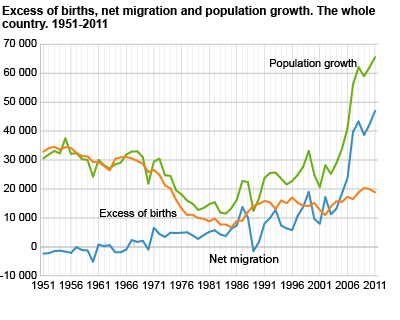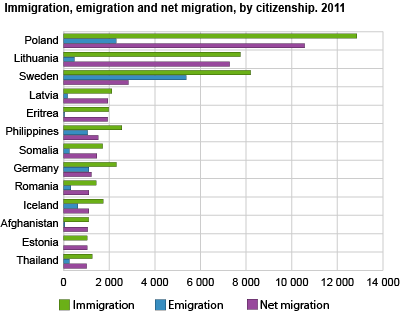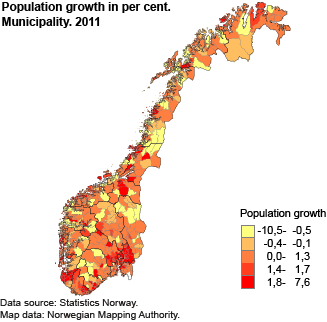Content
Published:
This is an archived release.
Soon we are reaching 5 millions
At the beginning of the year, there were 4 985 900 residents in Norway, which gives a population growth of 65 550 or 1.3 per cent in 2011. This is the highest population growth ever. Immigration surplus accounted for 71 per cent of the growth.
The population growth of 1.3 per cent in 2011 was the highest since 1920. In Europe, only Luxembourg and Turkey have a higher percentage growth than Norway, among countries with reliable figures. Net migration from abroad increased by 4 700 or 11 per cent from 2010 to 2011, and is has never been higher. There were 79 500 registered migrations to Norway from abroad in 2011; an increase of 5 650. A total of 32 500 moved from the country, this is about 1 000 more people than last year.
|
The population as at 1 January 2012 is now published by sex and age. Figures for municipalities, counties and the country as a whole, distributed by one-year age groups and sex, are available in StatBank Norway. Furthermore, tables containing figures by sex and different age groups for municipalities, counties and the country as a whole are available at "Population statistics. Population by age, sex, marital status and citizenship". More data will be published on 14 March. In addition to the total numbers for births, deaths and migrations attached to this page, figures for migration by citizenship are available on request. More detailed statistics on births, deaths, internal migrations, and immigration and emigration will be published on 11 April, 19 April and 10 May respectively. Figures are now published for marriages, divorces and separations for counties and the whole country. These are available at "Population statistics. Marriages and divorces". More detailed information on these topics will be available in August. |
Somewhat lower fertility rate, but life expectancy still rises
There were born 60 200 children in 2011, that is 1 200 fewer than in 2010. A total of 41 400 persons died, 100 fewer than in 2010.
Total fertility rate for 2011 was 1.88, while the rate for 2010 was 1.95. For the last years, Norway together with Sweden has been at the top when it comes to fertility in Europe. Iceland, Ireland, France and Turkey are ahead of us.
A boy born in 2011 has a life expectancy of 79.00 years (up from 78.85 in 2010), while a girl can expect to be 83.45 years (compared to 83.15 in 2010).
Large immigration from Europe
Net migration from abroad increased from 42 600 in 2010 to 47 900 in 2011. Of this, 34 700 or close to three fourths, was net immigration of European citizens. The largest surplus consists of citizens from Poland and Lithuania, constituting half of the European immigrants. Eight of the 13 countries with a net immigration of more than 1 000 are European, and labour immigration is a major reason for coming.
Although net immigration of South European citizens increased, the figures are still low. Comparing emigration and immigration, it mostly was Swedes who left the country, 65 per cent, whereas the figure for Polish and Baltic citizens only totalled 12 per cent.
Highest population growth in Oslo and Akershus
Oslo and Akershus had by far the highest population growth in 2011, with a total of 24 700. That is 3 100 higher than last year.
The population in Rogaland and Hordaland grew by 13 400, which is 1 800 fewer than the previous year. All counties along the coast from Telemark to Sogn og Fjordane had a lower growth than last year.
Large immigration to Oslo and Akershus
All counties had a net immigration in 2011. The largest, in real figures as well as percentage, was in Oslo and Akershus.
Net immigration from abroad was particularly high in three parts of the country. Oslo and Akershus with 14 300 had the largest, flowed by Rogaland and Hordaland with 8 200 and Møre og Romsdal and Sør-Trøndelag with 5 400. This net immigration from abroad made up for domestic immigration loss and birth deficit. Population grew in all counties, but it would have decreased in eight of them had they not experienced the net immigration from abroad.
Eight counties had a domestic net immigration. Akershus and Østfold had the largest, having a short commuting distance to Oslo.
Population grew in 311 municipalities, whereas 114 experienced a decrease. 219 municipalities had a birth surplus, whereas 203 had a deficit. As for domestic migration, 172 municipalities had a surplus and 253 a deficit. Among the municipalities with the largest deficit, many were situated in the northern-part of Norway.
Population grew in 311 municipalities, whereas 114 experienced a decrease. 219 municipalities had a birth surplus, whereas 203 had a deficit. As for domestic migration, 172 municipalities had a surplus and 253 a deficit. Among the municipalities with the largest deficit, many were situated in the northern part of Norway.
Tables:
The statistics is published with Population.
Contact
-
Statistics Norway's Information Centre
E-mail: informasjon@ssb.no
tel.: (+47) 21 09 46 42




